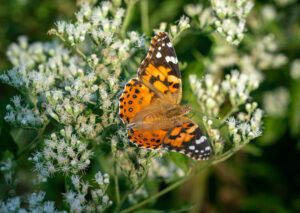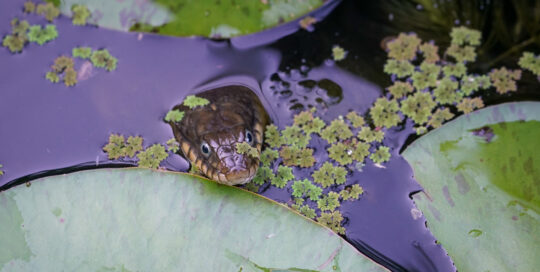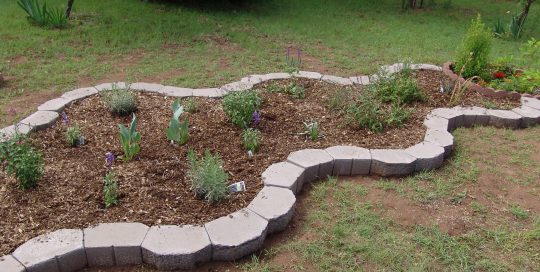Boneset Attracts Pollinators in Late Summer and Fall
Views: 603

Writing this blog is always a learning experience for me. I have no formal training in botany beyond my Master Gardener classes (no surprise there, I’m sure), so I’m continually learning about plants like any other gardener. Today, I thought I’d write about a plant that has done stellar in my garden. It started from seed I’d picked up in a field somewhere in southwestern Oklahoma. It has never needed watering, occasionally gets mowed down by my spouse, and yet still manages to bloom cheerfully in late summer when heat and drought are killing other flowers.
I knew it as Boneset, so I was a little puzzled when my blog research turned up Boneset, a plant that loves moist, rich, soil. That’s definitely not the plant in my yard, so further research yielded Late Boneset, a more likely fit for the pollinator powerhouse that laughs at heat and drought in my yard. But, lo, there is a third species out there, as well, Tall Boneset. All three are closely related but fill slightly different ecological niches in their native habitats.
Three Eupatoriums (Bonesets)
Common names are not the best way of identifying plants due to confusion (such as my own) with the name “Boneset.” To be more specific, here are three Eupatoriums that may be of interest to wildlife gardeners:
-
Eupatorium perfoliatum (Common Boneset): needs moist, rich soil and would be a good choice for rain gardens
- Eupatorium altissimum (Tall Boneset): thrives in medium-moist to medium-dry soils
- Eupatorium serotinum (Late Boneset): the indestructible plant in my yard, that spreads easily by seed and rhizome, deer resistant
All three are native throughout the eastern half of the country and tolerate full to partial sun. While I’d hesitate to call their small white flowers “showy,” I find them attractive plants, if for no other reason than they are always abuzz with butterflies and bees while in bloom. To me, that makes them beautiful.

Boneset flowers may not be the most showy, but their visitors often are.
Why They’re Good for Wildlife
Boneset species are critical plants for supporting pollinators. They bloom in the late summer and fall when other flowers have already bloomed and faded. Late Boneset, asters, and goldenrods are the primary bloomers this time of year in my gardens. The timing is especially beneficial for late-season pollinators like monarch butterflies preparing for their long migration southward.
Boneset flowers are also a favorite of native bees, providing them with a rich source of nectar and pollen when resources can be scarce. My plants also attract beneficial insects such as hoverflies.
Common Boneset is a host plant to Spring Azure butterflies, and other Eupatoriums are likely hosts to various moths. Host plants ensure a good supply of caterpillars and insects to feed birds, especially baby birds in spring.
A Valuable Addition to Your Garden
Boneset species offer tremendous ecological value. Their ability to attract and support pollinators ensures that your garden continues attracting visitors throughout late summer and fall. Moreover, as a host plant, it plays a role in sustaining the next generation of moths and the birds that depend on them.
Meet Leslie Miller
Leslie Ann Miller shares 3.5 acres in rural Oklahoma with birds, butterflies and wide variety of animals. She is currently transforming her yard with plantings…
Leslie's Recent Posts

The Joy of Being a Wildlife Gardener: Wally and Wallaby






